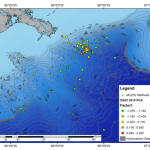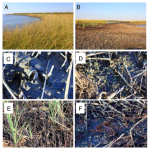Since its Sunday (and many of you are probably lapsing into a post-brunch pancake-induced sugar coma), I am presenting another Sunday roundup of recent oil spill news to peruse at your leisure…
There were warning flags about potentially faulty cement up to a month before the Macondo well blowout—Halliburton apparently did four tests on the cement and THREE indicated the mixture would fail (if something has 75% chance of failure, isn’t that a BAD sign?!?!). BP supposedly knew about this information from Halliburton’s report, but neither company appeared to do anything about this information. This is an important finding because if Halliburton is directly at fault it may have to shoulder some of the clean-up costs—not surprisingly, this caused a bit of a dip in share prices (understatement. ‘plummet’ is much more appropriate).
Since they were given cement that only had a 25% chance of working, rig workers should have noticed something was up when they were sealing up the well. Several negative pressure tests showed up to 1400 psi of force still on the drill pipe (a sealed well should have shown no upward pressure), but BP and transocean rig workers declared it successful. (Maybe because the number “1400” has two zeros in it? Are they just really bad at simple math? Is BP going to argue that our failing public schools were really the underlying cause of the oil spill?). Note: the pressure test was the ONLY TEST they used to tell if the well had sealed. Wouldn’t you want to pay REALLY CLOSE attention to this ONE data point? No one is still sure how this information was lost (viscous ‘spacer’ fluid could have given false positive readings), and no warnings were voiced in communications between the rig and engineers in Houston.
In any case, the Times-Picayune notes that “BP created additional, unnecessary risk by removing drilling mud and surface plugs that should have acted as barriers against gas blowing out”
On the positive (?) side, the Oil Spill Commission doesn’t think that BP was trying to adopt dodgy cost-cutting measures by lowering their safety standards
In other news, the White House had to issue a formal apology for incorrect wording in the May report that issued a 6-month moratorium on deepwater drilling. It incorrectly implied that the decision had been peer reviewed, prompting mass outrage. The lesson of this story: insomnia-induced report editing is never a good idea, no matter how awake you think you are at 2 AM.
New research also suggests that dioxin chemicals released from the controlled burns of oil shouldn’t increase cancer risks for workers exposed to fumes, or people who consumed fish exposed to the fumes. If this wasn’t oil spill research, the authors never would have gotten away with N=1 sampling regime
And for my WTF news story:
Apparently there was ANOTHER meeting in Florida that brought scientists together (although none of our group was there) and talked about collaborating and coordinating oil spill data:
At the top of their recommendations is the creation of a unified research and monitoring effort to detect the first signs of trouble with Gulf species and provide that information to management agencies to head off disastrous effects, said marine biologist Michael Crosby, senior vice president for research at Mote Marine Laboratory.
“Right now there is no agency that pulls together and coordinates all the information we need about the Gulf,” Crosby said Wednesday at the conclusion of the two-day symposium. “Scientists at different institutions might be collecting different pieces of data — but if we don’t put those together, we could miss the big picture until populations crash.”
The participants focused on the potential for “trophic cascades,” changes affecting a single or multiple species in the Gulf food chain that could cause stress or declines in populations of organisms at other stages in the food chain.
Scientists at the conference also raised concerns that information being gathered by federal, state and BP researchers as part of the federal Natural Resource Damage Assessment process will be kept from public distribution because of concerns it will be needed during possible court challenges.
HELLO?!?! We are studying a) the oil spill and b) organisms at the base of the food chain, so how did we not hear about this meeting? I looked at your press release and all I see mention of is corals, dolphins and sea turtles (not surprising since the WWF co-sponsored the meeting and is ALL about the vertebrates). This is another prime example of an event that seems like it was organized behind the scenes and not publicized until after the fact.
Also, you just totally shot yourself in the foot when talking about the disparate data. You will need data about microbial eukaryotes or else you WILL miss the big picture when the populations crash. How else are you going to predict knock-on effects up the trophic pyramid unless you incorporate the effects of producers and primary consumers?






I’m pretty upset I missed the symposium at Mote as well. Most mentions of the symposium DO seem to be after the fact, and most just summarize that there was a symposium but don’t get into the details.
Halliburton was also the concrete provider at Montara, but I’m not admitting or denying that they are at fault. I wonder how many wells may have insufficient concrete jobs that just have’nt exibited any signs of deterioration, yet.
Does the technology exist to retest the concrete?
What is the design life of such well work and plugs ?
(as an ex the Hoover dam has a design life of >1.5k yrs )
Whos liable for repairs after ‘x’ number of years?
Its virtually impossible to get these companies to accept responsibility when the oil is dripping off their shoes, what happens in 10 years after the GOM well develops old age fractures?